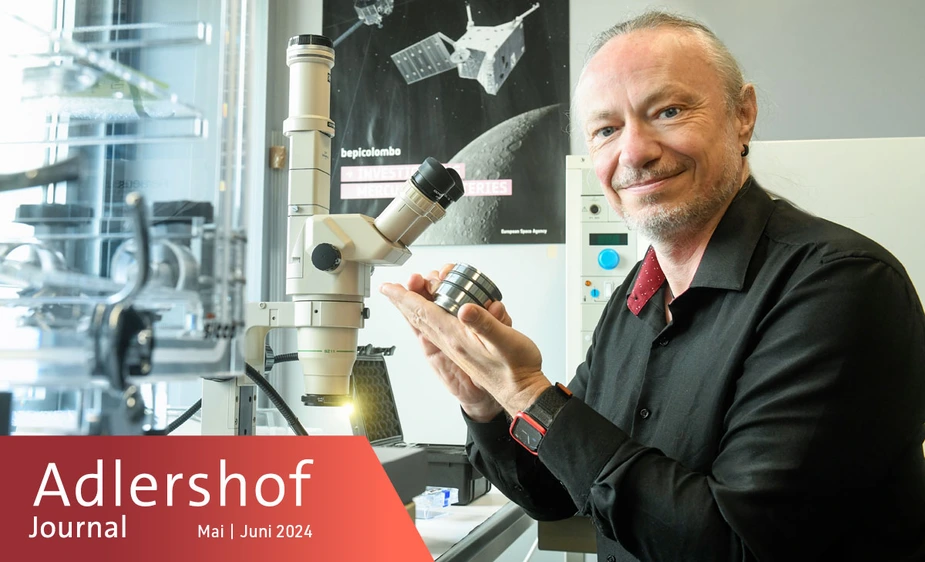A stroke of luck – The meteorite from the Havelland
Planetary researcher Jörn Helbert examined the very rare object in the DLR laboratory
Sunday, 21 January 2024. It’s about half past two. The night over Brandenburg is clear when, suddenly, a fiery streak illuminates the sky. A chunk of a rock from space, half a metre long and weighing about 140 kilos, makes its way through the atmosphere. The friction causes it to heat up, to glow, and a significant portion of it to evaporate. The rest bursts and rains down on the fields and pastures of the Havelland in many small pieces.
Impacts like these happen every day. An estimated 16,000 tonnes a year. Most of it gently rains down on us in the form of fine dust—too light to create friction rubbing against the air molecules. Larger particles, however, burn up completely in the atmosphere. They leave nothing behind but a trail of light. We know them as shooting stars. Only really big pieces of rock manage to reach the ground. A few hundred a year that are known as meteorites. Like the one in Havelland. Nobody could have guessed on that starry January night that this one was something very special.
Jörn Helbert knew nothing of the things happening in Berlin when he woke up at six am, a long way away in Spain. The head of Planetary Laboratories at the Institute for Planetary Research of the German Aerospace Center (DLR) in Adlershof was there for a research project. “I picked up my phone and saw the message,” he remembers. “I immediately contacted my colleagues in Berlin to coordinate the search for the fragments.” For the researchers, this event was exciting in many ways.
All this was preceded by an announcement. At the stroke of midnight, a Hungarian amateur astronomer discovered the object on a collision course with Earth. This has only happened seven times before. “This was a stroke of luck for us,” says Helbert. “This way we could calculate the trajectory and narrow down the scattering area.” Which is how astronomers refer to the region where the fragments hit the ground. In this case, it was “only” a few square kilometres in size. A few hours after the impact, the first researchers of DLR and the Natural History Museum Berlin were ready. They were supported by volunteers. However, the first piece was found by others. A group of Polish meteorite dealers were on site to recover some of the coveted pieces.
Helbert remembers: “We were under the assumption that it was a fairly common type of meteorite. A carbonaceous chondrite.” Hence, the searchers were on the lookout for small, black, charred-looking stones. Consequently, the surprise was immense when one of the meteorite dealers found a suspicious-looking, grey stone. An Aubrite. “We find those very rarely,” says the space researcher. “We have only been able to observe a handful during their fall.” After two weeks, there were 25 pieces in the collections of the DLR and the Natural History Museum. A total of 160 grams. To name the meteorite, it had to be classified first—a joint task of Helbert and the teams at DLR and the Natural History Museum. Their suggestion: “Ribbeck”, named after the estate, next to which the debris was found.
“We have then begun examining the fragments together with a large consortium of different research institutes,” says Helbert. Personally, he has a special interest in the meteorite. “The material is strikingly similar to the rock that we found on the surface of the planet Mercury.” A space probe called BepiColombo is currently on its way there and Helbert is in charge of the probe’s spectrometer. “Ribbeck has provided us with an analogue material that allows us to take measurements on Earth already,” he explains. “When the probe sends us the data from Mercury next year, we can make comparisons.”
There’s another reason he is so excited about the rare find. “The DLR is currently building a new analysis laboratory for samples from space,” he says. “Not just from space missions. Now, we already got out first sample of meteorite material sent home to us for free.”
Kai Dürfeld for Adlershof Journal
